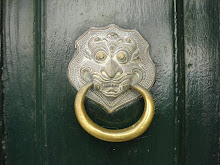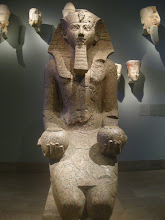We got there at around 11.30 am, with plans to spend the day shopping in Jerusalem. The sky was gray, the air chilly and we could perhaps have picked a better day for shopping, but nevertheless our spirits were high.
We parked (because we can't drive with a West Bank-registered car through Qalandia checkpoint), walked over towards the entrance that leads into this huge metal construction with corrugated tin roof and walls, and got in line. There were perhaps 50 or 70 people in front of us, plus another 60 or so already inside, past the first set of turnstiles--much like on any given day at around noon (in the mornings and afternoons it's much, much more crowded of course).
But before I go into what followed, let me tell you about Qalandia checkpoint. It is one of the 39 military checkpoints set up by Israel between the occupied West Bank on the one hand, and Israel and occupied East Jerusalem on the other. It is different from the about 60 permanent checkpoints inside the occupied West Bank that we have to cross whenever we pass from one West Bank city to another (or as in Hebron: from one street to another). These checkpoints are generally "drive-thru" checkpoints that annoy and take time (and, above all, create traffic jams) but are normally relatively easy to pass through. A lot of the times these days, we don't even have to show our IDs.
Qalandia checkpoint was at first a checkpoint on the road between Ramallah and Jerusalem set up in 2000, much like these internal checkpoints, but it has gradually been built to resemble a border-crossing-meets-slaughterhouse-meets-prison type of checkpoint over the past years. Like I said, it's a huge metal construction, and on each side of checkpoint the Apartheid Wall towers up against the sky. There's nowhere to go but through it if you want to cross to Jerusalem.
Of course, the absolute majority can't cross to Jerusalem. I can, because I have an international passport. My boyfriend can, because he has a temporary permit issued by Israel to cross over for work purposes.
Once you're inside the corrugated metal building, you have to stand in line in a narrow cage-like passage with metal bars on either side and above your head and wait for the Israeli soldiers to let you through the first 2 meter high turnstile, in small groups of ten or so. There are three passages, but normally only one is in use:
Waiting in Line at Qalandia Checkpoint
Then you have to go stand in line again, at one of five passages (of which usually one or maximum two are open at the same time). This passing takes time, because the Israeli soldiers behind their bomb proof glass only let two or three pass through the next 2 meter tall turnstile at a time.
(I would show you pictures, but it's forbidden to take pictures inside the checkpoint (the one above was taken by Tarek with his spy camera (read: cell phone)). But check out the picture slide on this Washington Post article about Qalandia, by Ben Hubbard).
As time passes, irritation grows and people start arguing and begin to blame each other instead of the Israeli occupation for the time they have to waste in line. Somebody tries to cut in line, another person forgets to take his belt off before he goes through the metal detector and has to go back. Because when you are finally let through this second turnstile, you have to put all your belongings on a conveyor belt, go through a metal detector, and show your ID and permit (or passport for internationals) to a usually very bored and most often arrogant Israeli soldier on the other side of the bomb proof glass. Then, you are free to pass through two more turnstiles and hop on a buss to Jerusalem on the other side of the Wall.
This is on a normal day. Yesterday, we had been standing in line for even longer than usual at the second turnstile before the metal detector and ID check, because the soldiers were slow with letting us pass, and also sent people back every now and then, denying them passage to Jerusalem for no apparent reason. Right before it was our turn to go through the turnstile, the soldier shouted out something in the speaker system that some of the others understood as "Women will not be let through here, all women must go stand in line three". I did hear the word "talateh" for three, and Tarek nodded, so I went to stand in line three with all other women, confused and annoyed at this new, bizarre (probably very temporary) policy.
I saw Tarek go through, but our line wouldn't move. The soldier had sent us there, but hadn't bothered manning the window. Would she send somebody? How long should we wait? Should we go back? No, one woman tried, and wasn't allowed to pass. Should we go somewhere else?
But there is no one to ask. There is no "Information Window"; no "Customer Service Central"--no phone to call and ask somebody in charge. Only soldiers in booths, unable to hear, and most likely unable to care. So we stood there and waited.
Finally, I went "Screw it!" on the inside and went over to line two. It was manned and there was about 35 people waiting to pass through the checkpoint. I had gotten no official permission to go over there, but I figured that since the line was mixed, it would be okay.
Then Tarek called on my cell phone. He told me that the Israelis had taken him to a small room where they had left him waiting. Without giving him a reason why he had been taken aside.
So there we were. Waiting on either side of the checkpoint. Waiting and waiting. We talked every two minutes or so, updating each other on what was happening (which was essentially nothing).
When they finally let Tarek go (still without an explanation), and when I had finally passed through the metal detector and ID check, it was after 2 pm and our mood was considerably less cheerful. We went shopping in the Arab neighborhood with renewed resolve to boycott everything Israeli.



















No comments:
Post a Comment